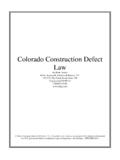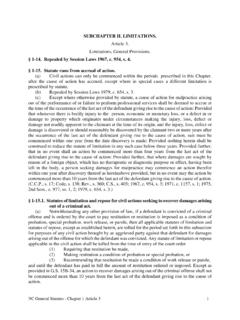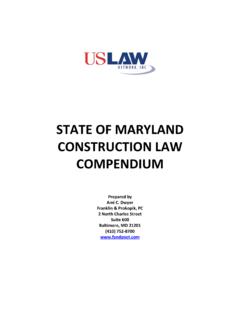Transcription of COLORADO’S HOMEOWNER PROTECTION ACT AND ITS …
1 COLORADO'S HOMEOWNER PROTECTION ACT AND ITS PROSPECTIVE. IMPACT ON CONSTRUCTION DEFECT LITIGATION . by Mark A. Neider, Esq. On April 11, 2007, the Governor of Colorado signed into law the HOMEOWNER PROTECTION Act of 2007" ( HPA ). This legislation was the result of a grass roots effort undertaken by plaintiff construction defect attorneys that significantly impacts the 2003. amendments to the Construction Defect Action Reform Act ( CDARA ) that limited the scope of damages that could be asserted against construction professionals in construction defect litigation. The HPA passed so quickly (44 days from introduction to Governor Action) that the Colorado Association of Home Builders ( CAHB ) had little time to organize an effective opposition.
2 The CAHB now considers itself as being in a position to resist further legislative change which they anticipate from a democrat controlled legislature and executive branch. Given the current political climate, the CAHB anticipates that it may take some time to enact legislation to address the issues discussed below to provide a more equitable footing for construction professionals in defending against claims of construction defects. The most important development under the HPA is the declaration that limitations in the form of waivers under builder/vendor contracts for claims of negligence and the implied warranty of habitability were declared void as against public policy. Subsection (a) of . 13-20-806(7), voids those terms of a builder's contract which calls for a waiver of rights to assert tort and breach of implied warranty claims to the extent they are recognized under CDARA and the Colorado Consumer PROTECTION Act ( CCPA ).
3 Section 13-20-804(d)(2)(a), of CDARA specifically states that CDARA shall not be construed to prohibit, limit or impair actions brought in tort, contract, warranty or for any violation of any statute or ordinance Copyright 2007 Mark A. Neider, Esq. other than violation of the building code. Many tract builders require home buyers, as part of a purchase and sale agreement, to waive any rights the home buyer may have to bring a claim for violation of the CCPA, breach of the implied warranty of habitability, and actions in tort including negligence in consideration of the builder's express warranty. It is also common for the builder vendor's purchase and sale agreement to require a waiver of the right to claim consequential damages, loss of use or other categories of damages to limit the amount of exposure attendant to a construction defect claim.
4 Home builders also typically limit the duration of their liability to the one year term of its express warranty. Subsection 804(d)(2)(a) is calculated to avoid such builder imposed limitations by declaring these waivers in violation of public policy. Under Subsection (a), the home builder may no longer limit theories of recovery to those recognized under an express warranty. Likewise, the home builder cannot limit the measure of actual damages defined at . (2) and 13-20-806, The operation of this new legislation will also apply to work performed by design professionals such as architects and engineers who are also considered subject to CDARA. pursuant to the definition of Construction Professional found at (4), Design professionals also commonly limit their damages exposure under their contracts to the amount of payment they receive for their design services.
5 The HPA will now condemn such practice as a violation of public policy. More importantly, Subsections (a) and (b) void any waiver or release of claims which have not yet accrued. This is an extremely significant development as many settlement agreements and releases executed between builders and home owners to resolve construction Copyright 2007 Mark A. Neider, Esq. defect litigation contain a do not darken my door step provision whereby claims yet to accrue are released. Under the terms of the HPA, so long as the claim has not accrued, it cannot be waived. The inability to obtain a release for alleged claims yet to accrue is significant. Homeowners can now institute defect litigation against a home builder or construction professional for as many as 8 years under the current statute of repose codified at 13-80-104, based on the discovery of ongoing manifestations of damages.
6 While the law in Colorado appears to favor construction professionals in the standards used to determine when a construction defect claim accrues, trial courts have a difficult time understanding and applying the this standard. For example, a common construction defect claim is that the ground around a residence is not properly sloped to drain water away from the structure as recommended under the soils report for a residence. Under Colorado law, the claim for this defect accrues when the HOMEOWNER discovers or should have discovered through the exercise of reasonable diligence the physical manifestation of the defect. See 13-80-104(1)(b)(I), The statute does not require that the cause of the defect or the identity of the responsible party be discoverable.
7 Tamblyn v. Mickey and Fox, Inc., 568 641, 642 ( ), rev'd on other grounds, 578 641 ( ). Rather, it is the manifestation of the physical condition indicating a defect that causes the action to accrue. Highline Village Assoc. v. Hersh Companies, Inc., 996. 250, 253 ( ), cert. granted on other grounds ( ). In this example, once the HOMEOWNER observes the flat ground around the residence, the claim should accrue. Yet many trial court judges do not understand the subtle distinction of this accrual Copyright 2007 Mark A. Neider, Esq. standard and apply the knew or should have reasonably known accrual standard typically used under contract and tort law. Based on the new provisions of the HPA, homeowners that enter into a settlement agreement on construction defect claims may continue to sue construction professionals for the entire 8 year statute of repose alleging that new construction defects accrued since the last settlement affected.
8 Subsection (c) of the HPA is the Habitat for Humanity exception that allows such non-profit and charitable organizations to limit their liability however they deem appropriate. Subsection (d) is intended to expressly maintain the limitation on CCPA damages which was the keystone to the 2003 amendments to CDARA. Finally, 13-20-807, , has been revised to clarify that any limitation on liability under warranty only applies to express warranty, not the implied warranties of habitability, good and workmanlike construction and code compliance. Many builders require a purchaser to waive these implied warranties in consideration of the express warranty the builder provides. Under the HPA, this limitation is no longer valid. The expectation is that the impact of the HPA will be more profound for larger tract home builders than smaller speculation home builders.
9 First, many smaller home builders do not require a waiver of the rights discussed above and therefore have always been subject to these claims. Accordingly, additional cases filed as a result of the ban on the waiver of future construction defects claims yet to accrue is not expected for this class of builder. Construction is not a perfect science and even the best plans can result in failed construction due to surrounding conditions. A home that experiences problems due to significant construction defects is likely to continue to manifest problems in one form or another. Copyright 2007 Mark A. Neider, Esq. Such ongoing manifestations will require the builder prove that the newly alleged defects actually accrued prior to the settlement which, as discussed above, is a challenge.
10 See Wildridge Venture v. Ranco Roofing, Inc., 979 282, 283 ( ). While employing a buy back settlement model can avoid these problems, this is not a viable option for multifamily housing litigation and situations where home owners are obsessively attached to their property. Time will tell as to what affect the HPA will have on the construction industry be it raising the standards of construction or the costs passed on to the consumers. _____. Mr. Neider is partner at the law firm of Harris Karstaedt Jamison & Powers, practicing in the areas of complex commercial and construction litigation. Mr. Neider has represented, developers, builders, general contractors and subcontractors in construction disputes in both jury trials and arbitrations.









